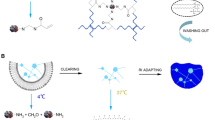The direct, highly selective and sensitive real-time imaging of neuro- and biochemical mediators is the only way to clarify precisely the chemistry of the brain and to discover the key molecular targets involved in regulation of brain homeostasis. To realize that, we need: high-speed deep-tissue imaging techniques with high spatial and temporal resolution; and ultra-fast and highly selective molecular sensors, giving a possibility to monitor target molecules directly in their physiological environment; in addition, these molecular sensors have to be comparatively small and permeable for blood-brain barrier, to be applicable in brain studies. The present view accents on the perspectives for development of direct approach for investigation of function/flow coupling phenomenon in the brain, based on the current progress in development of ultra-fast molecular sensors for direct visualization of biochemical mediators (e.g., nitric oxide, Ca ions), and high-speed two-photon/multi-photon deep-tissue imaging.

Similar content being viewed by others
REFERENCES
Ances, B. M. (2004). Coupling of changes in cerebral blood flow with neuronal activity: What must initially dip must come back up. J. Cereb. Blood Flow Metab. 24:1–6.
Bakalova, R., Matsuura, T., and Kanno, I. (2002). The cyclooxygenase inhibitors Indomethacin and Rofecoxib reduce regional cerebral blood flow evoked by somatosensory stimulation in rats. Exp. Biol. Med. (Maywood) 227:465–473.
Chaigneau, E., Oheim, M., Audinat, E., and Charpac, S. (2003). Two-photon imaging of capillary blood flow in olfactory bulb glomeruli. Proc. Natl. Acad. Sci. U. S. A. 100:13081–13086.
Chalon, S., Vancassel, S., Zimmer, L., Guilloteau, D., and Durand, G. (2001). Polyunsaturated fatty acids and cerebral function: Focus on monoaminergic neurotransmission. Lipids 36:937–944.
Dale, N., Hatz, S., Tian, F., and Llaudet, E. (2005). Listening to the brain microelectrode biosensors for neurochemicals. Trends Biotechnol. 23:420–428.
Fan, C., Plaxco, K. W., and Heeger, A. J. (2005). Biosensors based on binding-modulated donor–acceptor distance. Trends Biotechnol. 23:186–192.
Girouard, H., and Iadecola, C. (2006). Neurovascular coupling in the normal brain and in hypertension, stroke, and Alzheimer disease. J. Appl. Physiol. 100:328–335.
Hirase, H. (2005). A multi-photon window onto neuronal-glial-vascular communication. Trends Neurosci. 28:217–219.
Iadecola, C. (2004). Neurovascular regulation in the normal brain and in Alzheimer’s disease. Nat. Rev. Neurosci. 5:347–360.
Kagan, V., Bakalova, R., Koynova, G., Tyurin, V., Serbinova, E., Petkov, V. V., Petkov, V. D., Staneva, D., and Packer, L. (1992). Antioxidant protection in the brain against oxidative stress. In Packer, L., Prilipko, L., and Christen, Y. (eds.), Free Radicals in the Brain: Aging, Neurological and Mental Disorders, Springer Verlag, Berlin, pp. 49–61.
Lauritzen, M. (2005). Reading vascular changes in brain imaging: Is dendritic calcium the key? Nat. Rev. Neurosci. 6:77–85.
Lim, M. H., Xu, D., and Lippard, S. J. (2006). Vizualization of nitric oxide in living cells by a cupper-based fluorescent probe. Nat. Chem. Biol. 2:357–380.
Magistretti, P. J., Pellerin, L., Rothman, D. L., and Shulman, R. G. (1999). Energy demand. Science 22:496–497.
O’Neill, R. D., Lowry, J. P., and Mas, M. (1998). Monitoring brain chemistry in vivo: Voltametric techniques, sensors, and behavioral applications. Crit. Rev. Neurobiol. 12:69–127.
Phillis, J. W., Horrocks, L. A., and Farooqui, A. A. (2006). Cyclooxygenases, lipoxygenases, and epoxygenases in CNS: Their role and involvement in neurological disorders. Brain Res. Brain Res. Rev. 52:201–243.
Simard, M., Arcuino, G., Takano, T., Liu, Q. S., and Nedergaard, M. (2003). Signaling at the gliovascular interface. J. Neurosci. 23:9254–9262.
Solfrizzi, V., D’Introno, A., Colacicco, A. M., Capurso, C., Del Parigi, A., Capurso, S., Gadaleta, A., Capurso, A., and Panza, F. (2005). Dietary fatty acids intake: Possible role in cognitive decline and dementia. Exp. Gerontol. 40:257–270.
Strowbridge, B. W. (2006). Imaging activity in brain cells: Deconvultion clears the haze. Nat. Methods 3:344–346.
Takano, T., Tian, G-F., Peng, W., Lou, N., Libionka, W., Han, X., and Nedergaard, M. (2006). Astrocyte-mediated control of cerebral blood flow. Nat. Neurosci. 9:260–267.
Voltera, A., and Meldolesi, J. (2005). Astrocytes, from brain glue to communication elements: The revolution continuous. Nat. Rev. Neurosci. 6:626–640.
Wang, X., Lou, N., Xu, Q., Tian, G-F., Peng, W. G., Han, X., Kang, J., Takano, T., and Nedergaard, M. (2006). Atrocytic Ca2 + signaling evoked by sensory stimulation in vivo. Nat. Neurosci. 9:816–823.
Yehuda, S., Rabinovitz, S., Carasso, R. L., and Mostofsky, D. I. (2002). The role of polyunsaturated fatty acids in restoring the aging neuronal membrane. Neurobiol. Aging 23:843–853.
Zonta, M., Angulo, M. C., Gobbo, S., Rosengarten, B., Hossmann, K-A., Pozzan, T., and Carmignoto, G. (2003). Neuron-to-astrocyte signaling is central to the dynamic control of brain microcirculation. Nat. Neurosci. 6:43–50.
Author information
Authors and Affiliations
Corresponding author
Rights and permissions
About this article
Cite this article
Bakalova, R. Ultra-Fast Biosensors and Multi-Photon Microscopy in the Future of Brain Studies. Cell Mol Neurobiol 27, 359–365 (2007). https://doi.org/10.1007/s10571-006-9129-6
Received:
Accepted:
Published:
Issue Date:
DOI: https://doi.org/10.1007/s10571-006-9129-6




